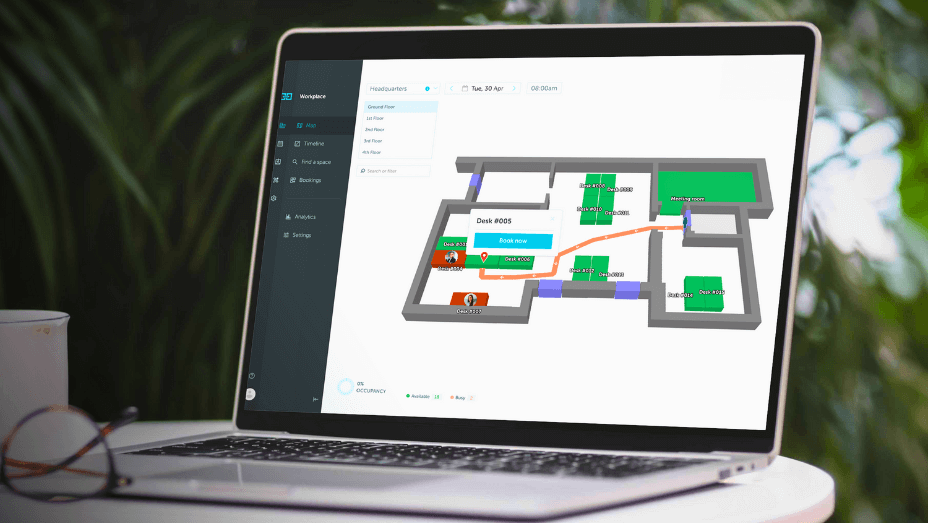In an era where borders blur and digital highways pave the path for global commerce, businesses increasingly expand beyond their hometown horizons. Whether driven by market demand, strategic partnerships, or the quest for diverse talent, the proliferation of multiple office locations has become not just a trend but a necessity for growth.
Today, companies manage teams distributed across continents, time zones, and cultures. This dynamic landscape brings both promise and perplexity. While the prospect of tapping into new markets and talent pools is exciting, the challenging task of maintaining cohesion and efficiency across multiple office locations looms large.
In this article, we embark on a journey to uncover eight best practices for mastering multi-location management. So, buckle up as we explore the roadmap to success in the interconnected world of multiple offices. Let’s begin.
TL;DR:
- Effective management in multi-office setups is crucial for sustaining cohesion, productivity, and success across various locations.
- Challenges include communication barriers, collaboration difficulties, logistics management dilemmas, technology integration issues, maintaining a consistent corporate culture, and budgeting complexities.
- Set clear, localized goals and functions for each office to leverage regional strengths and opportunities.
- Standardize key processes across all locations to ensure consistency, efficiency, and uniform client service.
- Implement office mapping and wayfinding technology to improve navigation and connectivity within office spaces.
- Encourage collaboration among offices to break down operational silos and enhance cross-functional cooperation.
- Adopt effective communication strategies and use the same technology across all locations to streamline operations and support.
- Leverage office management data for informed decision-making and commit to continuous evolution and adaptation to changing circumstances.
The Significance of Effective Management in Multi-Office Setup
Effective management holds profound significance in a multi-office setup, acting as the linchpin that sustains cohesion, productivity, and overall success. Coordinating operations across multiple office locations demands adept leadership capable of navigating diverse environments, fostering collaboration, and aligning disparate teams toward shared goals.
Effective management ensures streamlined communication channels, harmonized workflows, and optimized resource allocation, mitigating the risks of fragmentation and inefficiency inherent in decentralized structures. Moreover, it cultivates a unified organizational culture, instilling in employees a sense of belonging and purpose at work regardless of geographical dispersion.
By prioritizing clear direction, strategic oversight, and adaptability, effective management in a multi-office setup enhances operational efficiency and nurtures innovation, resilience, and sustained growth in today's dynamic business landscape.

Challenges in Managing Multiple Locations Effectively
Managing multiple offices certainly comes with its own set of challenges. To tackle them in various location, effective resource management is crucial. Here, we’ll dive deep into some of the most common hurdles organizations encounter and try to explain why they shouldn’t be taken lightly.
Communication and Collaboration Hurdles
While managing offices spread across different locations, effective communication is one of the first challenges. Remote team interactions can fall prey to misunderstandings due to a lack of face-to-face interaction, differing time zones, or language barriers.
Another challenge lies in fostering collaboration between distributed teams as it becomes difficult for employees in different offices to work together on projects when geographical distance separates them. The rift can potentially lead to decreased productivity and morale.
Logistics Management Dilemmas
Managing logistics across several locations is no small feat either. Issues such as inventory control, supply chain management, distribution efficiency, and delivery accuracy are magnified when dealing with a multiple-office setup. It's common for businesses operating from multiple office locations to see inconsistencies arising from incoordination within their logistical systems.
Aligning People and Goals Across Locations
Another significant hurdle is aligning people towards a shared goal while remaining sensitive about individual objectives. Monitoring key performance indicators (KPIs) is crucial in ensuring alignment and productivity across multiple locations. Ensuring every employee understands their role and how it contributes to the larger organizational goals simplifies office management. However, this task becomes more complicated when it must be done across many locations.
Technology Integration Concerns
Every successful modern business leverages technology for better performance. However, integrating technology into diverse systems across multiple locations presents many problems, such as data security risks, system compatibility queries, issues with software license management, etc., possibly impeding the smooth flow of operations within multi-location establishments.
Maintaining Consistent Corporate Culture in Multiple Locations
Creating a solid corporate culture company-wide gets complicated when you have multiple offices involved – cultivating camaraderie gets trickier with distance playing spoilsport. Organizing team building activities is crucial in nurturing a cohesive organizational culture and promoting collaboration among employees. Ensuring everyone feels part of the bigger picture while nurturing individual team identities can seem like a tightrope.
Cost Considerations for Each Office
Last but certainly not least, budgeting poses separate challenges when managing offices in different locations. A strategy that works well for one branch might be financially disastrous for another. Striking a balance between the economy of operations and retaining regional specificity is an art form that many companies need to master on their way to successful multi-office business management.

8 Best Practices for Managing Multiple Business Locations and Offices
With careful planning and management, overseeing multiple offices or locations doesn't have to be a Herculean task anymore. Here are some best practices that can help you streamline your multi-office setup.
#1: Set Clear Goals and Functions for Each Office
Like each machine cog, every single office in a business is essential. Competent managers set clear goals and distinct functions tailored for each location. Instead of simply mirroring operations across all sites, design operations based on local strengths, opportunities, demographics, and market demands. This practice fosters operational efficacy that reflects positively within the organization and enhances customer satisfaction.
#2: Standardize Processes Across Teams and Locations
Maintaining consistency in multiple locations is indeed challenging, but it's more manageable by standardizing key processes. Regular tasks such as reporting protocols or approval systems must operate on similar principles regardless of geographical location. Uniformity promotes efficiency, reduces misinterpretation risks, minimizes errors, and, most importantly, ensures client services look and feel the same no matter where they may be provided.
#3: Consider Office Mapping and Wayfinding Technology
Office mapping and wayfinding technology are highly effective for managing multiple office locations. Providing clear, interactive office maps and directions simplifies navigation within office spaces, ensuring that employees and visitors can easily find their way around. This enhances the efficiency of moving through different offices and fosters a more connected and accessible workplace environment. Implementing such technology is wise for any organization looking to streamline operations and improve the experience across its locations.

Yarooms Workplace Experience Platform, integrated with Mappedin's digital indoor mapping technology, provides accurate real-time navigation within the office space.
#4: Encourage Collaboration Among Offices
Operational silos can create friction within an organization, impeding cross-functional cooperation among multiple teams and locations. Instead, encourage active collaboration, establishing common objectives for projects that require cross-functional intervention. This approach enhances knowledge sharing and fosters an enriching experience for all stakeholders involved.
#5: Implement Effective Communication Strategies
Effective communication forms the backbone of any successfully managed business with multiple locations. Good communication strategies improve understanding, trustworthiness, and alignment across diverse teams. From arranging regular one-on-one calls to adopting a multi-channel approach, including email, instant messaging tools, or video conferencing, it can promote transparency within your multi-office setup.
#6 Use Same Technology in All Office Locations
Using the same technology across all office locations is a key strategy for enhancing operational efficiency and communication within a company. When every office uses the same systems and software, it drastically reduces the learning curve for employees who move between locations or collaborate with teams in different areas. This uniformity ensures everyone is on the same page, facilitating smoother information exchange and workflow management. Moreover, it simplifies IT support and maintenance, as the IT team can apply the exact solutions and updates across the board. Adopting a unified technology approach is a smart way to create a cohesive, efficient, and well-connected organization.
# 7 Leverage Office Management Data
Leveraging office management data across all locations is a strategic approach that significantly enhances decision-making and operational efficiency within an organization. For instance, understanding how meeting rooms are utilized can inform the need for more or fewer spaces, or analyzing desk occupancy can lead to more flexible working arrangements. Additionally, by uniformly applying this approach across all offices, organizations can ensure consistent service and efficiency, enabling a more cohesive and streamlined operation.
#8: Commit to Continuous Evolution and Adaptation
Multi-office management is a dynamic process that demands continuous evolution and adaptation. To maintain resilience against changing circumstances, it becomes critical to evaluate performance periodically for all offices separately and collectively. Moreover, be receptive to feedback from individual teams; being on ground zero, they are likely to provide insights that may not be apparent otherwise.
Ensuring Success in a Multi-office Setup
Operating a multi-location business can feel like controlling an orchestra from miles away. But don't be fretful! There are effective strategies that you can adopt to ensure smooth management.

Goal Setting Guidelines for Individual Offices
The key pillar supporting a successful multi-office setup is setting individual goals for each office. This crucial step helps maintain focus and direction while allowing sufficient flexibility to cater to unique workplace cultures. Consider the following:
- Tailored Objectives: Firstly, set objectives that speak directly to the responsibilities and expertise of each office. For instance, your Research & Development department might have innovation-focused goals.
- Harmony with Overall Business Goals: Ensure these individual goals align seamlessly with your business's broader scope and vision—think of it as painting parts of a larger picture.
- Flexibility: While maintaining consistency is critical, creating some wiggle room for unpredicted changes or milestones specific to different locations is equally essential.
- Measurability: Last but not least, set SMART (Specific, Measurable, Achievable, Relevant, Time-bound) goals to gauge progress effectively along the way.
This process allows employees in all locations – in Taipei or Texas –—to understand their contribution individually and collectively towards the company's success.
Technological Solutions to Improve Efficiency while Managing Multiple Office Locations
In this digital age where remote work and global businesses have become commonplace, leveraging technological solutions significantly aids in managing multiple offices more efficiently:
- Collaboration Tools: Applications like Slack or Microsoft Teams enhance internal communications, ensuring seamless real-time collaboration across various time zones and engaging everyone in meaningful discussions.
- Cloud-based Applications: Platforms like Trello or Asana offer shared spaces where teams from different locations can simultaneously work on projects, keeping tasks organized and accessible.
- Video Conferencing Services: Services like Zoom or Google Meets bridge the distance between offices, making them feel closely connected.
- Project Management Systems: Tools such as Basecamp and Monday.com simplify the delegation and tracking of tasks, making what could be administrative chaos a manageable process.
- All-round workplace management platforms: YAROOMS Workplace Managemement Platform revolutionizes the management of multiple locations by integrating desk and room booking, hybrid work scheduling, visitor management, and more into one unified system. This platform simplifies operations, enhances efficiency, and ensures equitable resource access across all locations, fostering a cohesive workplace culture. It also empowers management with data insights, enabling them to identify trends and optimize space utilization across multiple offices, thereby supercharging decision-making. By streamlining administrative tasks and providing actionable intelligence on office usage, YAROOMS improves the workplace experience for employees and drives strategic advantages for organizations in multi-office setups.
Managing multiple locations isn't necessarily an uphill battle if you arm yourself with robust strategies and today's technological advancements. The goal is to weave together different threads of diverse offices so they beautifully fall into this complex tapestry we call 'multi-office business.' Step up onto that podium, raise your conductor's baton, and let harmony prevail!
Building a Strong Company Culture Across Multiple Office Locations
Building a solid company culture across multiple office locations requires a deliberate and strategic approach to ensure consistency and inclusivity. When managing multiple teams across different locations, it is crucial to emphasize cultural awareness and effective delegation. It starts with clearly communicating the company’s vision, values, and goals, ensuring these foundational elements are universally understood and embraced.
Leveraging technology, such as collaborative tools and platforms, facilitates seamless interaction and fosters a sense of community among employees, regardless of their geographical location. Regular virtual and in-person meetups can enhance team bonding and promote a unified company identity.
Recognizing and celebrating each office's diverse cultures and contributions while aligning them with the company's core values strengthens the collective company culture. Meanwhile, leadership plays a crucial role in modeling these values, providing support, and ensuring all employees feel valued and connected to the larger mission.
This multifaceted approach to nurturing a strong company culture across various locations boosts employee morale and satisfaction and drives organizational success by cultivating a cohesive, motivated, and engaged workforce.

Conclusion: Key Takeaways for Successful Management of Multiple Offices
As we approach the end of our journey to manage teams across multiple locations, there are some critical principles and practical strategies to emphasize. These key takeaways will guide you in navigating the challenges of managing operations across diverse sites.
Firstly, clear objectives for each office should always be defined. While all branches contribute to the larger organizational structure, they have unique roles. Setting specific goals ensures that each location aligns with the company’s overall success.
Secondly, standardized processes are essential across all your locations. These create consistency, ensuring that all employees understand expectations, regardless of their geographic location. This approach fosters unity and smooth operations across multiple locations.
Leverage technology to streamline operations. Tools like cloud-based software, communication tools, and collaboration platforms help teams work together seamlessly, no matter the distance. These tools are vital for managing teams across multiple locations effectively.
Building a unified company culture is equally important. Strong communication—through conference calls, virtual meetings, or other methods—reinforces shared values and goals, bridging the gap between offices.
Finally, adaptability is key. The ability to evolve processes and embrace new solutions ensures long-term success as you are managing teams across multiple locations. Regularly reviewing and refining strategies is essential in today’s dynamic business environment.










